Travel > Central America
Central America
Vibrant Cultures and Subtropical Paradise
Central America beckons with its breathtaking landscapes, captivating history, and a tapestry of vibrant cultures. From pristine beaches to verdant rainforests and majestic volcanoes, this enchanting region offers an array of experiences that are bound to delight retirees seeking new horizons. Let's embark on a journey through some of the top travel destinations in Central America, unveiling the wonders that await.
Belize
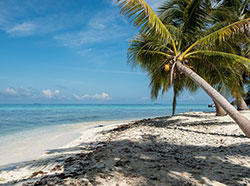
Photo by hat3m / Pixabay | Belize, a hidden gem, invites you to immerse yourself in its aquatic wonders. Dive into the depths of the Great Barrier Reef, a vibrant ecosystem teeming with marine life that will leave you breathless. Uncover the secrets of the ancient Maya as you explore their enigmatic ruins nestled within the lush rainforests. Seek solace in wildlife refuges that harbor a dazzling array of flora and fauna.
|
| Best Time to Visit: The best time to visit Belize is during the dry season, which typically spans from late November to April. This period offers pleasant weather with plenty of sunshine, making it ideal for outdoor activities such as exploring the stunning Belize Barrier Reef, visiting ancient Mayan ruins, and venturing into lush rainforests. However, keep in mind that this is also the peak tourist season, so popular destinations might be more crowded. If you prefer fewer crowds and don't mind some occasional rainfall, the shoulder seasons of May and October can still offer enjoyable experiences while providing a more tranquil atmosphere.
|
Costa Rica
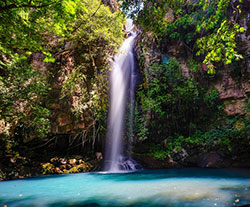
Photo by Frank Ravizza | Costa Rica, is a paradise for nature enthusiasts. A tapestry of national parks, wildlife refuges, and captivating landscapes awaits your exploration. Visit the refreshing Rio Celeste Waterfall in Tenorio Volcano National Park, or catch a wave while surfing at Manuel Antonio National Park. For an little excitement, take a thrilling whitewater rafting adventure down the Pacuare River, or lose yourself in the charm of Arenal Volcano National Park, where peaceful sloths laze in the trees and nature thrives.
|
Delight in the symphony of colors and melodies as you venture into the Monteverde Cloud Forest, a haven for birdwatching enthusiasts.
Best Time to Visit: The best time to visit Costa Rica is during the dry season, which generally falls between December and April. This period offers sunny weather and lower chances of rainfall, making it perfect for exploring the country's breathtaking beaches, lush rainforests, and diverse wildlife. It's an excellent time for outdoor activities like hiking, zip-lining, and surfing. However, it's important to note that popular tourist destinations can be more crowded during this peak season. If you prefer to avoid the crowds and don't mind occasional showers, the "green season" from May to November showcases Costa Rica's lush landscapes and is a great time to enjoy discounted prices and fewer tourists.
|
Guatemala
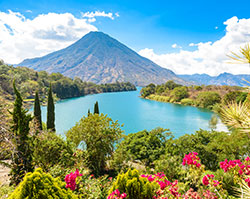
Photo by Dannhauer / iStock |
Step into Guatemala, a land steeped in a vibrant tapestry of history and culture. Unearth the remnants of the ancient Mayan civilization as you traverse the ruins of Tikal, where towering pyramids stand as silent witnesses to a bygone era. Conquer the heights of Volcán de Agua, granting you a panoramic vista that evokes a sense of awe and wonder. Immerse yourself in the colonial charm of Antigua Guatemala, a UNESCO World Heritage Site, or wander through the bustling Chichicastenango market, where the vibrant colors and intricate crafts of the Maya culture.
|
Best Time to Visit: The best time to visit Guatemala is during the dry season from November to April when the weather is favorable for outdoor activities and exploring. If you're interested in witnessing traditional cultural events, visiting during the Lent and Easter period, which falls in March or April, provides a unique experience with colorful processions and religious celebrations.
The rainy season from May to October can offer lush landscapes but expect sporadic showers and potential road closures. Note that the heaviest rainfall usually in June and July.
In the highland areas, including popular destinations like Antigua and Lake Atitlán, the temperatures tend to be cooler, especially during the evenings. It's advisable to pack layers to accommodate the temperature changes.
|
Nicaragua
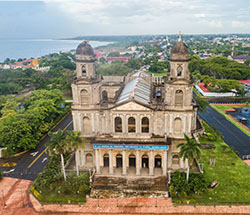
Photo by Roberto Zuniga / Pexels |
Nicaragua invites you to indulge in its natural splendor, with pristine beaches, majestic volcanoes, and lush rainforests at your finger ips. Explore the untouched beauty of its coastal gems, let the warm sand embrace your feet as you stroll along the shoreline. Marvel at the raw power and beauty of its volcanoes, and lose yourself in the colonial towns that whisper tales of a rich heritage. Discover Nicaragua's vibrant culture and savor the flavors of its delectable cuisine, including mouthwatering dishes like gallo pinto and vigorón, while enjoying the warm hospitality of its people.
|
Best Time to Visit: the dry season, which typically runs from November to April. This period offers the most favorable weather conditions for exploring the country and engaging in outdoor activities. If you're interested in cultural events, visiting during late November to early December allows you to experience the vibrant festivities of the country's patron saint celebrations, including La Purísima and La Gritería.
If you plan to visit during the rainy season, which occurs from May to October, you should be prepared for frequent showers and the possibility of tropical storms or hurricanes, particularly in September and October. While this period may have more rainfall, it can still be a good time to visit if you're interested in lower tourist crowds, lush green landscapes, and potentially lower prices for accommodations.
|
Panama
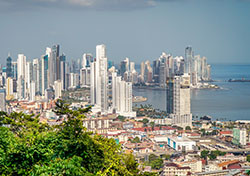
Photo by Adobe Stock | Panama, home to the magnificent Panama Canal, stands as a testament to human ingenuity. Witness the marvel of this engineering feat that connects the Pacific and Atlantic Oceans, shaping global trade. Beyond the canal, Panama boasts a modern capital, stunning beaches, lush rainforests, and majestic mountains. Feel the soft sand between your toes at Bocas del Toro, immerse yourself in the untamed beauty of Darién National Park's rainforests, or wander amidst the ancient ruins of Panama Viejo, a testament to the region's rich history.
|
Best Time to Visit: Panama has a tropical climate with two distinct seasons. The dry season generally runs from mid-December to mid-April, while the rainy season occurs from May to November. However, if you're interested in experiencing Panama's lush rainforests, observing wildlife, or enjoying lower tourist crowds, the rainy season can be a good option. The rainforest thrives during this time, and you can witness vibrant vegetation and impressive waterfalls. Just keep in mind that heavy rains and occasional thunderstorms are common, so it's essential to pack appropriate rain gear.
It's worth noting that Panama's climate can vary across different regions. For instance, the Caribbean coast tends to have more rainfall throughout the year compared to the Pacific coast.
|
Central America Travel Planning Tips:
Best Time to Visit: The best time to visit South America varies by region and activity. For travelers over 50, consider the dry season, which typically falls between May and September. This is an ideal time for outdoor exploration, sightseeing, and cultural experiences. However, keep in mind that the southern hemisphere's seasons are opposite to those in the northern hemisphere.
Transportation:
Central America provides a variety of transportation choices to suit different preferences. Buses are a cost-effective and convenient option, connecting major cities and towns. They also allow you to interact with local communities and fellow travelers. Domestic flights are useful for covering longer distances, especially if you want to save time. Trains are available in certain areas and offer picturesque routes, such as the scenic train journey through the mountains in Costa Rica. Car rentals are another possibility for exploring remote regions at your own pace and crafting a personalized travel itinerary.
Health and Safety Tips:
- Exercise caution regarding your personal belongings to prevent theft, especially in crowded tourist areas.
- Avoid wearing expensive jewelry or displaying valuable items to minimize the risk of attracting unwanted attention.
- When crossing streets, be vigilant as traffic regulations might not be strictly enforced.
- Opt for bottled water to stay hydrated and avoid consuming tap water, which may not be safe.
- Take precautions against mosquito-borne illnesses such as malaria and dengue fever. Use insect repellent and wear protective clothing to reduce the risk.
- Choose reputable transportation services or arrange transfers in advance, particularly when arriving at or departing from airports.
- Stay informed about the safety conditions in the regions you plan to visit and follow advice from local authorities.
- Respect visa regulations and adhere to permitted stay durations to avoid legal complications.
Travel Visa Requirements
It is crucial to adhere to immigration regulations and visa requirements while traveling in Central America to ensure a smooth and hassle-free journey. Overstaying your visa can lead to serious consequences in some countries. Here are some tips to help you avoid any issues related to overstaying your visa:
- Know Your Visa Requirements: Before traveling to Central America, thoroughly research the visa requirements for the specific countries you plan to visit. Each country has its own rules regarding entry, duration of stay, and visa extensions. Familiarize yourself with the visa regulations and ensure that you meet the necessary criteria.
- Check Visa Validity Period: Carefully review the validity period of your visa and make sure you understand the maximum duration of stay allowed. Some visas may have specific conditions or restrictions, such as a limit on the number of days or requirements for visa extensions. Be mindful of these details to avoid overstaying.
- Plan Your Itinerary: Plan your itinerary in advance and make sure it aligns with the duration of your visa. Consider the time you intend to spend in each country and calculate the number of days you will be staying. Allow for some buffer time to account for unexpected delays or changes in your travel plans.
- Monitor Your Visa Expiry Date: Stay vigilant about the expiration date of your visa. Mark it on your calendar or set reminders to ensure you are aware of when your visa is due to expire. Avoid leaving it until the last minute to address any necessary visa extensions or depart the country within the permitted timeframe.
- Seek Visa Extensions, if Needed: If you find yourself in a situation where you need to extend your visa due to unforeseen circumstances or changes in travel plans, contact the local immigration authorities or embassy of the respective country. Follow the proper procedures for visa extension and submit the required documentation within the designated timeframe.
- Consult with Local Authorities: If you have any doubts or questions regarding your visa status or duration of stay, seek assistance from local immigration authorities or reputable legal professionals. They can provide accurate information, guidance, and support to help you navigate the visa regulations effectively.
- Respect Local Laws and Customs: While traveling, it is essential to respect the local laws, customs, and regulations of the countries you visit. Engaging in any illegal activities or violating visa rules can have severe consequences. Stay informed about the local laws and abide by them to ensure a safe and enjoyable journey.
- Travel Advisories Stay updated on current events, local regulations, and any travel advisories when traveling abroad. Visit the US Government State Department Travel Advisories web site to check on the status of your destination.
- Enroll in the STEP Program: Travelers are also urged to enroll in the U.S. State Department's Smart Traveler Enrollment Program (STEP) to receive security messages and to make it easier to locate them in an emergency. The Department uses these security messages to convey information about terrorist threats, security incidents, planned demonstrations, natural disasters, etc. In an emergency, please contact the nearest U.S. Embassy or consulate or call the following numbers: 1 (888) 407-4747 (toll-free in the United States and Canada) or 1 (202) 501-4444 from other countries.
Remember, visa regulations and enforcement can vary from country to country. It is your responsibility as a traveler to comply with the immigration laws of the countries you visit. By being knowledgeable, proactive, and respectful of visa requirements, you can avoid any issues related to overstaying your visa and ensure a positive travel experience throughout Central America.
| |
 Photo by Alexander Dummer
 Beautiful beach in Manzanillo, Costa Rica
Photo by Juhku
 Resplendent Quetzal
Photo by Jonnathan Marin
 Photo by Roberto Zuniga

Photo by Caleb Jimenez
|
 Photo by Alexander Dummer
Photo by Alexander Dummer Beautiful beach in Manzanillo, Costa Rica
Beautiful beach in Manzanillo, Costa Rica Resplendent Quetzal
Resplendent Quetzal Photo by Roberto Zuniga
Photo by Roberto Zuniga Photo by Caleb Jimenez
Photo by Caleb Jimenez